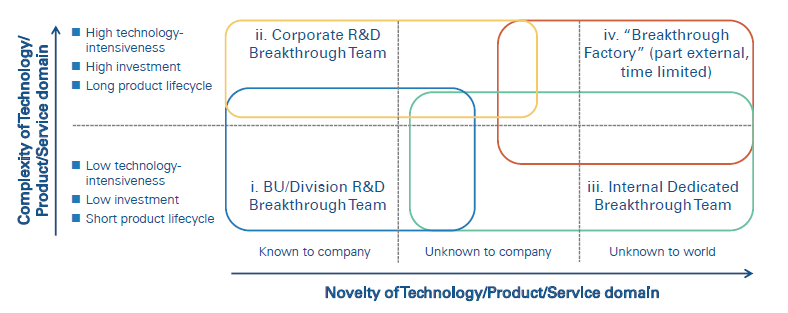Companies increasingly must be able to deliver breakthrough innovations (meaning radically new products, performance features, business models or market space) to respond to emerging competition, disruptions to core business, and increasing customer power.1 To explore best practices for delivering a consistent pipeline of breakthrough innovations, Arthur D. Little recently conducted a survey of large organizations worldwide.2 Nearly all (88%) participating companies expressed dissatisfaction with their efforts to date, and not a single respondent reported being very satisfied.
The survey indicated several key factors for achieving replicable, effective breakthrough innovation, including having an explicit breakthrough strategy with clear and quantified goals, single-point accountability and commitment at top management levels, cross-functional involvement, ring-fenced funding, active intrapreneur roles, and Agile processes. While having a dedicated breakthrough team is the most effective basic organizational approach, there is no one-size-fits-all model for how best to implement it. As we explore in this Advisor, we have identified four alternative models involving different functional ownership and resourcing. Companies should select the right models to suit the technology-intensiveness of the business and the novelty of the challenges they are tackling.
Although nearly 90% of companies recognized the importance of defining specific strategic objectives for breakthrough innovation, only about half of them currently do so. Those that do define specific breakthrough objectives and goals are, on average, nearly four times more satisfied with the results than those that do not, and the more explicit the goals are, the higher the success rate. We also found that companies with longer experience of working with business intelligence (BI) in a structured way have more explicit breakthrough innovation objectives than others, and that the more successful companies have specific target allocations for the resources they expect to dedicate.
The time frame of breakthrough projects can be long, posing challenges to sustaining commitment versus other shorter-term priorities. Over half of the survey participants quoted an average time to revenue from breakthrough products and services of between three and 10 years. The main challenges reported were conflicting short-term and long-term needs, along with difficulties in assessing future value — further underpinning the need to set clear goals and challenges to be overcome as well as a stable investment plan with dedicated resources, at least for the coming key stages of the program.
Half of the participating companies regarded their breakthrough innovation leadership and governance structure as ineffective or very ineffective, including both experienced and less experienced practitioners. The top reported challenges were an inability to commit to the cause and allowing short-term objectives to cannibalize breakthrough efforts.
What sets successful companies apart is not the choice of leadership model; leadership by the CEO, CTO, an innovation council or committee, and the top team are adopted almost equally. The main differentiator that emerges is whether they employ a governance approach, which ensures long-term accountability and commitment.
The Right Organizational Model
Having a dedicated breakthrough team is considered to be the most effective basic approach and yields 15% higher satisfaction than companies with no dedicated organization. Working with a dedicated team is also the choice of the more experienced companies. Crucial to any dedicated team’s success, however, is that it is implemented in a way that suits the nature of the issue at hand. The complexity and novelty of the technology, product, or service for the company can provide some guidance on the best way to organize breakthrough teams.
For example, if the domain is known to the organization, the R&D function or an existing business unit (BU) may be the best home for the breakthrough team. If it is unknown, stand-alone teams may be more suitable. Similarly, if the domain is highly technology-intensive or complex with high investment needs, a centralized rather than divisional or BU approach may be preferable. Large companies may choose to, and often do, use more than one model simultaneously.
We identified four generic organizational models that are effective in different circumstances (see Figure 1):
-
BU/division R&D breakthrough teams are good “minimum investment” options where the ideas or concepts are not new and the technical complexity does not require major long-term effort and investment. However, such teams are unlikely to be able to cope with high complexity and risk and are susceptible to short-term BU reprioritization pressures.
-
Corporate R&D breakthrough teams are better suited to more technology-intensive or higher investment domains that require a longer-term perspective and specialist technical skills. However, teams parented under corporate R&D are susceptible to overemphasis on “technology push,” becoming misaligned with the business, and being stifled by corporate control and culture, which may act as a major barrier to breakthrough thinking.
-
Internal dedicated breakthrough teams — with multifunctional membership separate from corporate R&D and reporting directly to the top team — enjoy the freedom to operate outside core product development procedures and controls. They may be more effective in pursuing areas of more uncertainty requiring greater stretch, but they also need careful governance to avoid becoming disconnected from the business and to ensure that they deliver short-term value. They are often susceptible to cuts as a result of short-term pressures.
-
The breakthrough factory focuses on development of a pipeline of radical or game-changing innovations that push the boundaries of science. It uses mainly external hires with time-limited contracts, led by an internal senior project leader with deep technical or scientific knowledge as well as entrepreneurial capabilities. This model is especially effective in technologically complex domains with high uncertainty where faster progress is needed. Time limitation means that the best individuals can be hired on merit, even if they don’t fit the typical corporate profile. Google ATAP and Defense Advanced Research Projects Agency (DARPA) are based on similar structures (Google ATAP is telecom-focused, and DARPA commissions advanced research for the US Department of Defense).

Key Success Factors
Whichever model is adopted, the survey revealed a number of key success factors for making it work effectively:
-
Cross-functionality. Ensure genuine co-involvement of a wide range of functions, including R&D, manufacturing, marketing, and customer insight. The more successful companies actively engage and involve cross-functional resources rather than simply having cross-functional steering groups.
-
Ring-fenced funding. Establish ring fencing to enable stable investment over the longer time frame needed for breakthrough projects and prevent short-term cannibalization. Staged funding release can help to manage the risks involved.
-
Intrapreneurs. Employ and encourage strong intrapreneurs as breakthrough leaders to drive concepts through to commercial exploitation. Intrapreneurs, like successful entrepreneurs, are individuals with the ability to pursue a commercial vision with dedication, inspire others to join the cause, take measured risks, and protect an effort through to market, securing needed resources along the way.
Focus on Effective Trend Monitoring and BI
Trend monitoring and BI were rated as the most important and most widely used practices to achieve breakthrough results. Traditional approaches to BI involving periodic data gathering and analysis are rapidly being superseded by more sophisticated Internet-based tools. Examples include continuous semiautomatic scanning using algorithms, natural-language processing, modeling and simulation, and two-way processes whereby information is shared as well as retrieved. Successful breakthrough innovators make adding to their knowledge a regular habit in the same way that top incremental innovators do.
Applying Agile Processes
Successful breakthrough teams apply Agile processes, drawing on approaches used effectively by startups. In practice this means:
-
Being very clear about the goal and the technical challenges that must be overcome to achieve the goal. Rigorous quantitative analysis is often required to do this.
-
Planning should be light and agile, involving several iterations, with fast and purposeful meetings (e.g., Scrum approaches).
-
Where possible, teams should adopt rapid prototyping and try to engage customers early with fast repetition (“build-measure-learn”). Progress is best assessed by tracking iterations to see how they are converging on goals, revealing dead ends, uncovering scientific advances, and so on.
-
Projects should be killed in a timely way. Setback or failure is sometimes the most effective tool for discovery. The project leader should let team members proceed only as long as they can see that the approach might ultimately work within the project constraints. If it becomes clear that an approach won’t work or requires “multiple miracles,” then the approach should be shut down and resources shifted elsewhere.
The Innovation Ecosystem
Surveyed companies indicated that active management of external networks and partners was very important for successful breakthrough innovation, yet on average most were only either partially satisfied or unsatisfied with their efforts.
The best performers in this area have developed a clear strategy for innovation ecosystem management and its contribution. They recognize that working within the ecosystem is a two-way process, much more than just contracting out some research projects to a university. They work to develop a shared vision within the ecosystem and they agree on transparent IP arrangements and frameworks, with an openness to sharing information once these are in place. They look to lead and influence the ecosystem in the most business-critical areas, and they use the right “enablers” to develop and manage the network (e.g., social networking, virtual environments, and physical collaboration spaces).
Fail Again, Fail Better
Individuals involved in breakthrough efforts are encouraged to stretch themselves beyond their comfort zone in an environment that allows failure. The survey findings confirm that a culture that does not accept failure is one of the most significant barriers toward achieving breakthrough innovation. Most concepts do not make it into adulthood. This is normal and should be recognized early on. The key to success is to have a portfolio approach to breakthrough innovation and to ensure that the there is always another project to move on to.
Conclusion
Finding the right approach for effective serial breakthrough innovation has become the holy grail for today’s companies. However, our survey shows that there is still a long way to go before companies’ efforts match their aspirations. While there is no single formula for success, it is clear that there are some important key factors for success.
The first prerequisite is having a well-defined breakthrough strategy and goals. Clear top management accountability and commitment are essential. Companies need to choose the right organizational model for the breakthrough team to suit the nature of the business and its challenges. And they need to have the right approaches for funding, involvement of multiple functions, intrapreneurship, ecosystem management, Agile processes, and encouragement of creativity. With all these components in place, and unflinching top management commitment, all the evidence is that serial breakthrough innovation is real and achievable for any company.
1For more on breakthrough innovation, see “The Breakthrough Incubator: A Radical Model for Innovative New Business” and watch the Cutter Consortium webinar, “How to Innovate Innovation: Creating New Stepout Businesses.”
2The Arthur D. Little survey included 83 companies from more than 30 different industries in 14 countries, with an emphasis on business-to-business and European-based companies.





